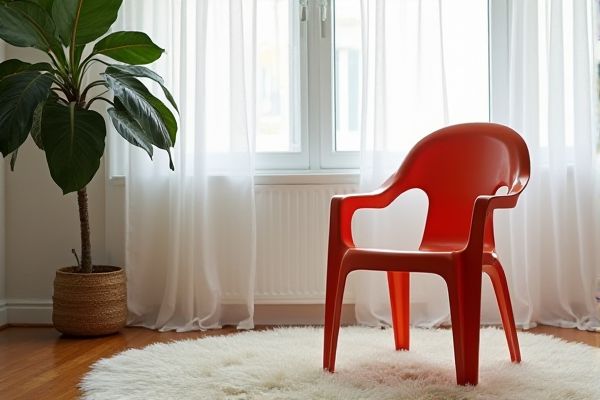
Plastic chairs offer lightweight convenience and affordability, while resin chairs provide enhanced durability and resistance to weather conditions, making them ideal for outdoor use. Explore the rest of the article to discover which option best suits your needs and lifestyle.
Table of Comparison
| Feature | Plastic Chair | Resin Chair |
|---|---|---|
| Material Composition | Polypropylene or polyethylene | Polyurethane or synthetic resin blend |
| Durability | Moderate, prone to cracking under stress | High, resistant to impact and wear |
| Weather Resistance | Susceptible to UV damage and fading | UV-resistant, suitable for outdoor use |
| Weight | Lightweight and easy to move | Moderate weight, stable and sturdy |
| Comfort | Basic, limited ergonomic design | Often molded with ergonomic features |
| Cost | Generally low-cost | Higher price due to material quality |
| Maintenance | Easy to clean, but less resistant to stains | Low maintenance, stain and scratch resistant |
| Environmental Impact | Less eco-friendly, non-biodegradable | More eco-friendly options available |
Introduction to Plastic and Resin Chairs
Plastic chairs, made from various polymers such as polypropylene or polyethylene, are lightweight, affordable, and widely used for both indoor and outdoor seating. Resin chairs, crafted from synthetic resins like polyester or epoxy, offer enhanced durability, resistance to weather elements, and a more polished aesthetic suitable for upscale environments. Both materials provide versatile seating solutions, with resin chairs often preferred for their superior strength and resistance to wear compared to standard plastic chairs.
Material Composition: Plastic vs. Resin
Plastic chairs are typically made from synthetic polymers such as polypropylene or polyethylene, known for their lightweight and flexible nature, whereas resin chairs use a composite material often incorporating polyurethane or polycarbonate, resulting in enhanced durability and weather resistance. Resin chairs generally offer superior strength and longevity due to their denser molecular structure, making them less prone to cracking or fading compared to standard plastic chairs. The choice between plastic and resin materials significantly impacts the chair's performance in outdoor environments and overall lifespan.
Durability: Which Chair Lasts Longer?
Resin chairs typically offer greater durability than plastic chairs due to their composition, which is often reinforced with fiberglass, providing enhanced resistance to wear and environmental factors such as UV rays and moisture. Plastic chairs, usually made from polypropylene or polyethylene, are more prone to cracking and fading over time, especially when exposed to direct sunlight and temperature fluctuations. Choosing resin chairs can result in longer-lasting furniture suitable for both indoor and outdoor use, making them a more cost-effective option in the long run.
Design and Style Differences
Plastic chairs often feature simple, solid construction with a focus on affordability and functionality, making them ideal for casual or utilitarian settings. Resin chairs, made from synthetic polymer materials, offer greater versatility in design, allowing for intricate patterns, textured finishes, and more contemporary or elegant styles. The durability and weather resistance of resin also enable designers to create molded, ergonomic shapes that enhance both comfort and aesthetic appeal.
Comfort Comparison
Plastic chairs often provide less ergonomic support and can feel rigid during extended use, leading to discomfort. Resin chairs, made from flexible synthetic materials, offer better contouring to body shapes, enhancing comfort and reducing pressure points. The durability and slight cushioning of resin contribute to a more pleasant seating experience compared to traditional plastic chairs.
Weather Resistance and Outdoor Use
Resin chairs offer superior weather resistance compared to standard plastic chairs, with enhanced UV protection and greater durability against moisture and temperature fluctuations. Your outdoor space benefits from resin's ability to maintain color and structural integrity even under prolonged sun exposure and rain. Plastic chairs may degrade or become brittle faster, making resin chairs the preferred choice for long-lasting outdoor furniture.
Maintenance and Cleaning
Plastic chairs require minimal maintenance, needing only occasional wiping with a damp cloth to remove dirt and stains. Resin chairs offer enhanced durability against UV rays and weather, making them easier to clean without fading or cracking over time. You can maintain both types with mild soap and water, but resin chairs generally provide longer-lasting, low-maintenance use in outdoor settings.
Environmental Impact
Plastic chairs often contribute to environmental pollution due to their reliance on non-biodegradable petroleum-based materials and challenges in recycling, leading to increased landfill waste. Resin chairs, typically made from synthetic or natural resins, can offer improved durability and sometimes incorporate eco-friendly or recycled components, reducing their ecological footprint. Choosing a resin chair can help minimize your environmental impact by supporting longer-lasting products with potential for better end-of-life recycling options.
Cost Analysis: Affordability Comparison
Plastic chairs are generally more affordable due to lower manufacturing costs and widespread availability of materials like polypropylene and polyethylene. Resin chairs, often made from durable synthetic resins such as polypropylene blended with fiberglass, tend to have higher production costs, reflecting increased durability and weather resistance. Choosing between the two depends on budget constraints and the desired lifespan, with plastic chairs being cost-effective for short-term use while resin chairs offer better long-term value despite higher upfront costs.
Which Chair Should You Choose?
Plastic chairs offer affordability and lightweight portability, making them ideal for temporary or indoor use, while resin chairs provide enhanced durability, weather resistance, and a more polished appearance suitable for outdoor settings. Resin's UV protection and sturdier construction ensure longer lifespan with minimal maintenance compared to basic plastic options. Your choice depends on the balance between cost-effectiveness and durability based on the chair's intended environment.
 homyna.com
homyna.com